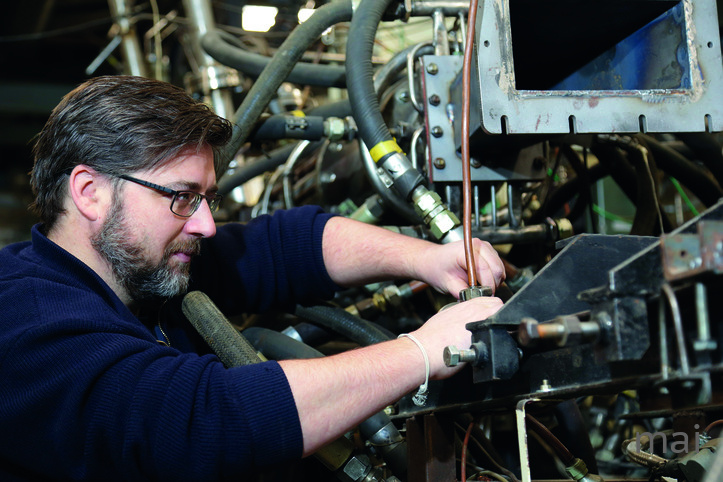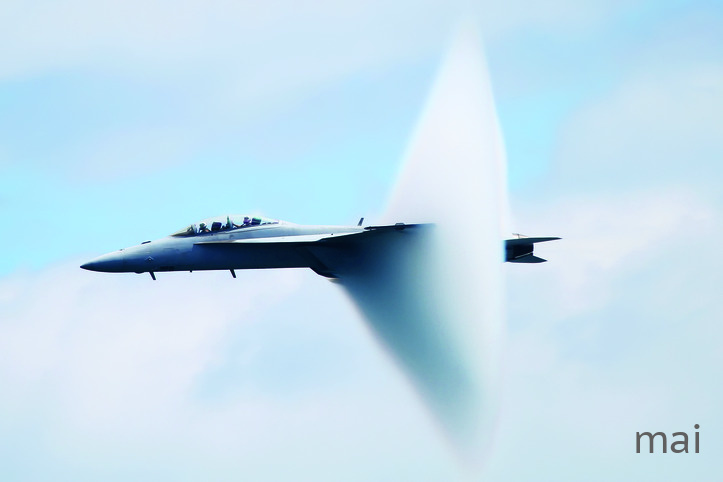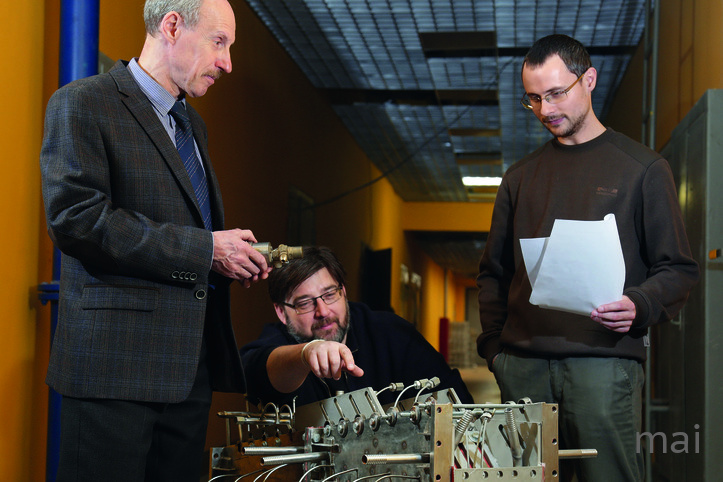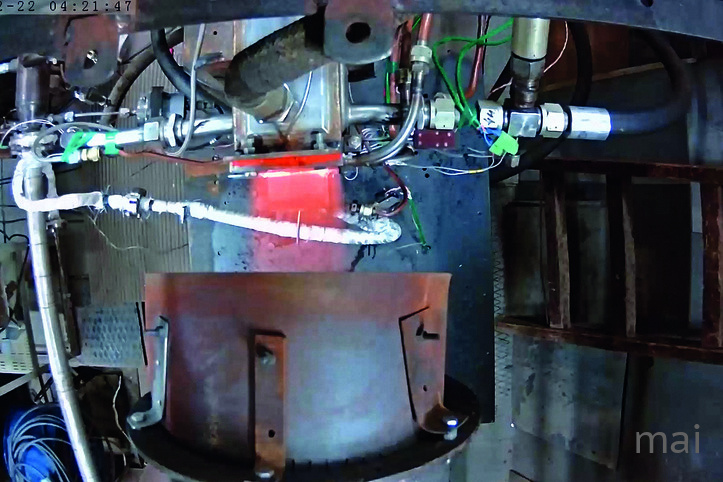MAI straight flow

In the MAI laboratory of the Department 201( Institute №2 "Aviation, Rocket Engines and Power Installations") successfully tested a new air-breather engine, which is capable to work in the hypersonic range of speed. In future such engines will be used in the very different aircraft. For example, they will significantly reduce the cost of launching payloads to near-earth orbits. MAI is one of the world leaders in the testing “straight flows” as it has developed a unique stand by targeted public funding.
Combat Debut
June 12, 1944, evening. German long-range artillery, which was located in the Calais area, in the north of France, conducted an unusually heavy bombardment of the British Isles. The British considered this to be the answer to the Allied landing in Normandy, which took place six days earlier. At 4 a.m. on June 13, the shelling was completed. However, after some time, British observers noticed in Kent a kind of "aircraft". The device made strange sounds, in its tail part a bright glow was seen. A strange "aircraft" flew over Downs, then dived and exploded near the town of Gravesend, in the area of the airfield, where the Royal Air Force fighter aircraft were based. The explosion, however, did not cause any damage. This was the first combat application of the German cruise missile Fieseler Fi 103, better known as V1 flying bomb. During the following hour, three more such vehicles fell in Kakfield, Bethnal-Grin and Platt. Then the Germans began their daily systematic bombardment of English cities, using the V-1. The British nicknamed them buzzing bombs because of the characteristic sound produced by their engines.

Missile engine, known as Argus As-014, was some kind of technical innovation then. It was the first time when the pulse air-breather engine (kind of the jet engines) was used for the serial vehicles. The tests on the stands and in the flight, carried out by German engineers before the war, showed a number of advantages of such engines over conventional piston aircraft engines. However, the chief designer of "V-1" Robert Lusser chose the ramjet for his cruise missile not for efficiency, but mainly because of the simplicity of the design, which promised small labor for production. This solution was fully justified. In a short time they managed to establish a mass production of Argus As-014, which more than 10 thousand pieces were collected until March 1945.
Some features
Well, ramjet has the simplest construction among all air-breather engines. In effect it is a “flying tube”. Engine consists of an air inlet, a combustion chamber, where relative airflow comes to, and fuel agent comes from fuel nozzles. Then after the combustion chamber goes an exhaust section. That’s all: no turbines, no fans.
The greatest efficiency of the thermal jet engines is achieved at hypersonic speed. Then it becomes more beneficial because of its weight and fuel economy in comparison with turbojets. During the flights into the atmosphere thermal jet engines are also more efficient than missiles jets, taking not only fuel but also oxidizing material, because “straight flows” use free air as oxidizing material.
“Aeroduct construction seems very simple. Nominally it is only a pipe,” – said a leading researcher of MAI Research Center 201, doctor of engineering sciences Valery Avrashkov. To tell the truth, such simplicity has a number of specific features in operation. The major one is that the ramjet does not have a takeoff thrust, it can’t be launched without the original velocity: while there is no relative airflow, the engine won’t turn on. Therefore, there is a need for means to ensure this very original velocity, that is, it needs to be accelerated to a certain speed first. There are different options for launching a thermal ramjet: either from a stationary ground launch catapult, or from a carrier aircraft, or using rocket launchers. The Germans, for example, launched their "V-1" mainly from ground-based steam catapults, based in France, although they also used carriers, converted from Heinkel He 111 bombers.

The higher the speed of the thermal ramjet at a constant altitude is, the higher the air flow through the engine and the higher the pressure in the combustion chamber will be. This allows increasing the thrust of the engine by increasing the fuel consumption. However, there are refinements.
“When this aircraft starts to move with a high super- and even hypersonic speed, very big problems begin,” - said Valery Avrashkov. – “The characteristics of the air intake are deteriorating. These are gas-dynamic losses that reduce the overall level of energy of the air coming into the combustion chamber. There are interesting works in TsAGI for creating a plasma in the air intake to break the shock waves and reduce the total pressure losses, but these technologies are far from practical application. And the second problem, which is becoming more serious with increasing speed of flight, is heating.” The higher the speed, the stronger will be the heating of both the vehicle and the ramjet from interaction with the air flow. On hypersound, for example, the speed is about 7 Mach, when theoretically the efficiency of the ideal engine should be the largest, the temperature of air entering the engine will be approximately 2100 K, this is practically a “cold plasma”. “Such devices require the use of new structural materials,”- said Valery Avrashkov. “They are already impossible to realize from relatively conventional high temperature alloys based on nickel and chromium. The cold resource of fuel, which is available on board the aircraft, is not enough at all. New high temperature composite materials will require new technologies for manufacturing aircraft and engine components”.
“Burya” and “Kholod”
So far abroad and in our country the thermal ramjets were used at supersonic speed – from 1 Mach increases to 5 Mach. After the World War II the most interesting vehicles with ramjets were designed in 1946-1950s by the French. Especially we should mention the unmanned and manned vehicles of René Leduc with supersonic ramjets. They started from the carrier aircraft and reached the speed of even more than 2 Mach.
In the mid of 1950s, the design bureaus of Semyon Lavochkin and Vladimir Myasishchev developed long-range cruise missiles "Burya" and "Buran." Their first stages were accelerators with rocket engines, and the second ones - vehicles with ramjets. The main driving force behind these projects was Mikhail Bondaryuk, who led the development of powerful marching supersonic ramjet engines in the 1950s. "Buran" remained on paper, but "Burya" was tested for about fifteen times in the 1957-1960s, in some of which the flight speed of the second winged stage with ramjet exceeded 3 Mach.

“At our museum of the 2nd faculty we have saved aeroduct cut in ¼ size, which had been installed on “Burya”, - told Valery Avrashkov. – “Perhaps it is the last “surviving” element of that cruise missile. If you look at it, you will see very high level technologies even for our time, used during its production”.
Nowadays ramjets because of their cheapness are most often used on military missiles and targets. In the future they are also likely to be used to launch vehicles into space. Of course, missiles engines now used on rocket-propellant vehicles make it possible to quickly accelerate and achieve space velocities. But with their use, the mass of the payload put into orbit is only 3-4% of the starting mass. All the rest is in “iron” and reserves of fuel and oxidizer. The use of a ramjet on the atmospheric part of the flight path of an aircraft makes it possible to deduce about three times more payload than using a missile engine alone, by reducing the required on-board reserve of the oxidant. Therefore, it is advantageous to use straightforward airspace systems on booster aircraft. An example of such a system is the project “Spiral”, developed in the MiG engineering department in the 1960s by the leadership of Gleb Lozino-Lozinsky, which provided for the launch of a space aircraft into the near earth orbit. It was planned to install the starting turbojet engines and the marching hypersonic ramjet on its accelerating aircraft. But the cost of such a device was very high, so it existed only in the form of a project.
Now experimental hypersonic ramjets already exist and have been tested in flight. In Russia, there are two vehicles within the framework of the "Kholod" program. Initially, they were developed by CIAM (Central Institute of Aviation Motor) and Turayev's engineering department “Soyuz”. Several experiments within the framework of the "Kholod" program were conducted with the participation and partial financing of the national scientific centers of France and the USA. So, on November 17, 1992, the engine was tested under a joint research program with the French aerospace research center ONERA (Office National d'Etudes el de Recherches Aerospatiales).

LEA on hold
According to the modern works on hypersonic ramjets, in which MAI participated, was the project “Prototype”, and then the joint Russian-French project of the pilot experimental hypersonic vehicle LEA. From the Russian side the main participant in it was engineering department "Raduga". Gromov Flight Research Institute in Zhukovsky assisted in carrying out tests, using a Tu-22M3 aircraft to accelerate to supersonic speed. The further dispersal should be carried out with the help of a rocket "Raduga D2". After separating the LEA from the rocket, it would have made an independent flight on hypersound for a long time.
MAI participated in the development for LEA project of a unique hypersonic ramjet. It should have been wide-range (accelerate the device from 2 to almost 7.5 Mach) with mechanical control of the flowing part.
Their foreign partners were ONERA center and the leading European developer and manufacturer of missile systems, MBDA (Matra BAE Dynamics Alenia). This project was carried out under the military-technical cooperation between Russia and France. “We conducted a full range of tests at MAI with parameters similar to flight ones,” - said Valery Avrashkov. – “A stand was specially designed for this purpose. It was created, of course, not from scratch, but on the basis of the experience that we already had.” A flight experiment should take place in 2014. The engine itself was ready, an aircraft for it, a test site in the territory of Russia. But, unfortunately, the “political situation” had changed that’s why the LEA project was stopped at the most interesting place.
“Of course, it is possible to finish LEA project on its own,” - Valery Avrashkov assured. – “But the program is very expensive, and the main part of the financing was provided by the French side. A similar national project called "Hammer" has now started. The project involves such organizations as TsAGI, CIAM, MAI and others. "
Council of Ministers money for stand
A bit of history. In 1966, a scientific group was organized at MAI Motor Department, which began to study the combustion chambers of the supersonic combustion ramjet. In 1969 it was decided to transfer to MAI stand equipment from the design engineering department “Krasnaya Zvezda” by the orders of Chief Designer Mikhail Bondaryuk, the construction of an experimental installation was started.

In the mid-1980s and in the 1990s, the 201st MAI Department worked together with the Turaev’s design engineering department “Soyuz”, which set the task for MAI students to create a combustion chamber for a hypersonic ramjet, but as a fuel it was not hydrogen but kerosene. Then the scientific supervisor of this work was the head of the Department 201 of Henrich Abramovich, and the immediate head of the research group was Sergei Baranovsky. Due to the developed new systems of injection of fuel into the supersonic flow and the start of the combustion process, as well as due to the correct profiling of the internal combustion chamber, MAI students managed to obtain a very effective process of burning aviation kerosene in such ramjet at very short distances. The results of these studies were used to develop such objects as a non-cooling combustion chamber made of a niobium alloy with a special coating and an axisymmetric scramjet made of powder and composite materials. Leading designer of these works was Vadim Levin.
Also the 9th Faculty also took part at this work, the Bardeen Central Research Institute of Research and Engineering and CIAM. “The length of our niobium alloy chamber was only 600 mm!” - recalled Valery Avrashkov. – “We conducted several tests at our stand. The camera survived!” With the results of this work, MAI came out in 1989 for a competition for receiving the Council of Ministers' Prize of the USSR. The competition was also attended by CIAM and TsAGI. But the winners were the collective of MAI - the scientific group from the Department 201 at that time was the leader in this matter. And today CIAM uses the results of that work, applying them in modern developments.
Nowadays there are two scenarios for testing hypersonic devices. The first one is “on the forehead”: the creation of an aerodynamic pipe, at the outlet of which there will be the same flow as in a real flight. Such pipes exist, but tests on them are insanely expensive. For example, one experiment lasting a few seconds on a similar pipe at the Samuel Langley’s Research Center in NASA is worth several million dollars.

There is also a simpler method, several orders of magnitude cheaper. It takes the ramjet, from which the air intake is cut off, into which air from the atmosphere enters with hypersonic speed and is inhibited there. And further on, the bench simulates those conditions that would have been in flight behind the air intake at the entrance to the combustion chamber. This is also done at the booth of the Department 201. “If we simulate, for example, a flight at a speed of 7.5 speed of sound, there Mach number will be no more than 3.5,” - says Valery Avrashkov. – “We take kerosene, air and oxygen, which enter a gas generator somewhat resembling the combustion chamber of a rocket engine. In it, kerosene burns, and we get the temperature that will be in real flight. By adding oxygen, we restore its concentration to atmospheric. The difference from the real flight, we will have clean air there, and then there will be an admixture of the combustion products of kerosene in the air. This somewhat affects the characteristics obtained in such an experiment. With the help of calculation and accumulated experience, we know how to accurately extrapolate the data to real flight conditions”.
Such experiments are conducted at MAI several dozen per year. Due to this stand, specially modified for new tasks, it was only at MAI that tests of the full-size LEA model were possible and all necessary characteristics were obtained. In the work on the topic LEA participated and CIAM for building mathematical models and performing calculations. Bench equipment, like the Maya, of course, exists in TsAGI, and in CIAM. But the stand at MAI was chosen because at the beginning of the work with the French there was already only a scientific and technical background in the field of research of mechanically controlled wide-range engines. Received in the late 1980s by the Council of Ministers of the Soviet Union, the department spent on retrofitting the stand. And due to the contract on LEA, stable financing was received to continue work and upgrade the bench equipment. Today, MAI stand for universality and the range of parameters obtained from Mach 2 to Mach 7+ remains almost unique.
“In addition, we have a fairly compact team that does not have a large administrative superstructure, as in large scientific organizations,” - added Valery Avrashkov. – “Therefore, we get results faster and cheaper.”